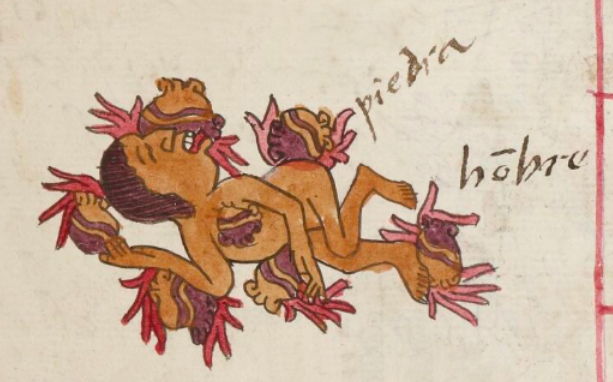tepanyaqui (TR17r)
This iconographic example from the Codex Telleriano-Remensis shows a horizontal, deceased man who has been stoned to death. He is shown in a semi-frontal (a twisted body), semi-profile view (his face). He is surrounded by seven stones, six of them with blood on them. The stones are the usual purple and orange, rounded shapes with curling ends. The purple and orange alternate in wave lines. The blood spurts something like water, but without the droplets or shells at the end of each spurt. The one stone that is in the location of his heart is pressing into his flesh but shows no blood. The man's hairstyle shows nothing unusual. The man's visible eye is closed, his red tongue protrudes, and his white upper teeth are visible. A gloss by his body clarifies that he was killed with stones (the Spanish word, "piedra").
Stephanie Wood
The gloss conveys that this man was executed for adultery. Additional information on the page says that after being killed, the bodies were thrown into the plazas for all to see.
Alonso de Molina provides the term for adulterer, tepanyaqui, which we have applied here.
The stone located in the approximate position of his heart has something of the shape of a heart.
Stephanie Wood
adulterio
ca. 1550–1563
Jeff Haskett-Wood and Stephanie Wood
crime, crimen, adulterio, adultery, men, women, hombres, mujeres, stoning, matar, muerte, ejecutar, ejecución, morir a apedradas, blood, sangre, eztli, stones, piedras, paliza, escarmiento, castigo
tepanyaqui, an adulterer, https://nahuatl.wired-humanities.org/content/tepanyaqui
el adultero
Stephanie Wood
Telleriano-Remensis Codex, folio 17 recto, MS Mexicain 385, Gallica digital collection, https://gallica.bnf.fr/ark:/12148/btv1b8458267s/f59.item.zoom
The non-commercial reuse of images from the Bibliothèque nationale de France is free as long as the user is in compliance with the legislation in force and provides the citation: “Source gallica.bnf.fr / Bibliothèque nationale de France” or “Source gallica.bnf.fr / BnF.”




